Emma Strubell
Structured Extraction of Process Structure Properties Relationships in Materials Science
Apr 04, 2025Abstract:With the advent of large language models (LLMs), the vast unstructured text within millions of academic papers is increasingly accessible for materials discovery, although significant challenges remain. While LLMs offer promising few- and zero-shot learning capabilities, particularly valuable in the materials domain where expert annotations are scarce, general-purpose LLMs often fail to address key materials-specific queries without further adaptation. To bridge this gap, fine-tuning LLMs on human-labeled data is essential for effective structured knowledge extraction. In this study, we introduce a novel annotation schema designed to extract generic process-structure-properties relationships from scientific literature. We demonstrate the utility of this approach using a dataset of 128 abstracts, with annotations drawn from two distinct domains: high-temperature materials (Domain I) and uncertainty quantification in simulating materials microstructure (Domain II). Initially, we developed a conditional random field (CRF) model based on MatBERT, a domain-specific BERT variant, and evaluated its performance on Domain I. Subsequently, we compared this model with a fine-tuned LLM (GPT-4o from OpenAI) under identical conditions. Our results indicate that fine-tuning LLMs can significantly improve entity extraction performance over the BERT-CRF baseline on Domain I. However, when additional examples from Domain II were incorporated, the performance of the BERT-CRF model became comparable to that of the GPT-4o model. These findings underscore the potential of our schema for structured knowledge extraction and highlight the complementary strengths of both modeling approaches.
International AI Safety Report
Jan 29, 2025Abstract:The first International AI Safety Report comprehensively synthesizes the current evidence on the capabilities, risks, and safety of advanced AI systems. The report was mandated by the nations attending the AI Safety Summit in Bletchley, UK. Thirty nations, the UN, the OECD, and the EU each nominated a representative to the report's Expert Advisory Panel. A total of 100 AI experts contributed, representing diverse perspectives and disciplines. Led by the report's Chair, these independent experts collectively had full discretion over the report's content.
Generate to Discriminate: Expert Routing for Continual Learning
Dec 22, 2024Abstract:In many real-world settings, regulations and economic incentives permit the sharing of models but not data across institutional boundaries. In such scenarios, practitioners might hope to adapt models to new domains, without losing performance on previous domains (so-called catastrophic forgetting). While any single model may struggle to achieve this goal, learning an ensemble of domain-specific experts offers the potential to adapt more closely to each individual institution. However, a core challenge in this context is determining which expert to deploy at test time. In this paper, we propose Generate to Discriminate (G2D), a domain-incremental continual learning method that leverages synthetic data to train a domain-discriminator that routes samples at inference time to the appropriate expert. Surprisingly, we find that leveraging synthetic data in this capacity is more effective than using the samples to \textit{directly} train the downstream classifier (the more common approach to leveraging synthetic data in the lifelong learning literature). We observe that G2D outperforms competitive domain-incremental learning methods on tasks in both vision and language modalities, providing a new perspective on the use of synthetic data in the lifelong learning literature.
Hardware Scaling Trends and Diminishing Returns in Large-Scale Distributed Training
Nov 20, 2024Abstract:Dramatic increases in the capabilities of neural network models in recent years are driven by scaling model size, training data, and corresponding computational resources. To develop the exceedingly large networks required in modern applications, such as large language models (LLMs), model training is distributed across tens of thousands of hardware accelerators (e.g. GPUs), requiring orchestration of computation and communication across large computing clusters. In this work, we demonstrate that careful consideration of hardware configuration and parallelization strategy is critical for effective (i.e. compute- and cost-efficient) scaling of model size, training data, and total computation. We conduct an extensive empirical study of the performance of large-scale LLM training workloads across model size, hardware configurations, and distributed parallelization strategies. We demonstrate that: (1) beyond certain scales, overhead incurred from certain distributed communication strategies leads parallelization strategies previously thought to be sub-optimal in fact become preferable; and (2) scaling the total number of accelerators for large model training quickly yields diminishing returns even when hardware and parallelization strategies are properly optimized, implying poor marginal performance per additional unit of power or GPU-hour.
Gradient Localization Improves Lifelong Pretraining of Language Models
Nov 07, 2024Abstract:Large Language Models (LLMs) trained on web-scale text corpora have been shown to capture world knowledge in their parameters. However, the mechanism by which language models store different types of knowledge is poorly understood. In this work, we examine two types of knowledge relating to temporally sensitive entities and demonstrate that each type is localized to different sets of parameters within the LLMs. We hypothesize that the lack of consideration of the locality of knowledge in existing continual learning methods contributes to both: the failed uptake of new information, and catastrophic forgetting of previously learned information. We observe that sequences containing references to updated and newly mentioned entities exhibit larger gradient norms in a subset of layers. We demonstrate that targeting parameter updates to these relevant layers can improve the performance of continually pretraining on language containing temporal drift.
Collage: Decomposable Rapid Prototyping for Information Extraction on Scientific PDFs
Oct 30, 2024



Abstract:Recent years in NLP have seen the continued development of domain-specific information extraction tools for scientific documents, alongside the release of increasingly multimodal pretrained transformer models. While the opportunity for scientists outside of NLP to evaluate and apply such systems to their own domains has never been clearer, these models are difficult to compare: they accept different input formats, are often black-box and give little insight into processing failures, and rarely handle PDF documents, the most common format of scientific publication. In this work, we present Collage, a tool designed for rapid prototyping, visualization, and evaluation of different information extraction models on scientific PDFs. Collage allows the use and evaluation of any HuggingFace token classifier, several LLMs, and multiple other task-specific models out of the box, and provides extensible software interfaces to accelerate experimentation with new models. Further, we enable both developers and users of NLP-based tools to inspect, debug, and better understand modeling pipelines by providing granular views of intermediate states of processing. We demonstrate our system in the context of information extraction to assist with literature review in materials science.
Scalable Data Ablation Approximations for Language Models through Modular Training and Merging
Oct 21, 2024


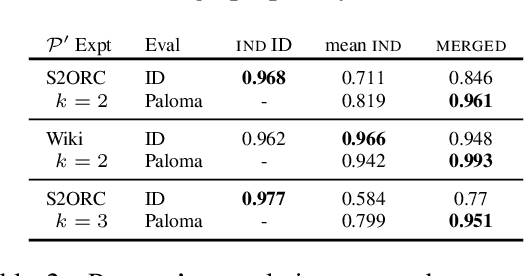
Abstract:Training data compositions for Large Language Models (LLMs) can significantly affect their downstream performance. However, a thorough data ablation study exploring large sets of candidate data mixtures is typically prohibitively expensive since the full effect is seen only after training the models; this can lead practitioners to settle for sub-optimal data mixtures. We propose an efficient method for approximating data ablations which trains individual models on subsets of a training corpus and reuses them across evaluations of combinations of subsets. In continued pre-training experiments, we find that, given an arbitrary evaluation set, the perplexity score of a single model trained on a candidate set of data is strongly correlated with perplexity scores of parameter averages of models trained on distinct partitions of that data. From this finding, we posit that researchers and practitioners can conduct inexpensive simulations of data ablations by maintaining a pool of models that were each trained on partitions of a large training corpus, and assessing candidate data mixtures by evaluating parameter averages of combinations of these models. This approach allows for substantial improvements in amortized training efficiency -- scaling only linearly with respect to new data -- by enabling reuse of previous training computation, opening new avenues for improving model performance through rigorous, incremental data assessment and mixing.
Stereotype or Personalization? User Identity Biases Chatbot Recommendations
Oct 08, 2024Abstract:We demonstrate that when people use large language models (LLMs) to generate recommendations, the LLMs produce responses that reflect both what the user wants and who the user is. While personalized recommendations are often desired by users, it can be difficult in practice to distinguish cases of bias from cases of personalization: we find that models generate racially stereotypical recommendations regardless of whether the user revealed their identity intentionally through explicit indications or unintentionally through implicit cues. We argue that chatbots ought to transparently indicate when recommendations are influenced by a user's revealed identity characteristics, but observe that they currently fail to do so. Our experiments show that even though a user's revealed identity significantly influences model recommendations (p < 0.001), model responses obfuscate this fact in response to user queries. This bias and lack of transparency occurs consistently across multiple popular consumer LLMs (gpt-4o-mini, gpt-4-turbo, llama-3-70B, and claude-3.5) and for four American racial groups.
What is Your Data Worth to GPT? LLM-Scale Data Valuation with Influence Functions
May 22, 2024



Abstract:Large language models (LLMs) are trained on a vast amount of human-written data, but data providers often remain uncredited. In response to this issue, data valuation (or data attribution), which quantifies the contribution or value of each data to the model output, has been discussed as a potential solution. Nevertheless, applying existing data valuation methods to recent LLMs and their vast training datasets has been largely limited by prohibitive compute and memory costs. In this work, we focus on influence functions, a popular gradient-based data valuation method, and significantly improve its scalability with an efficient gradient projection strategy called LoGra that leverages the gradient structure in backpropagation. We then provide a theoretical motivation of gradient projection approaches to influence functions to promote trust in the data valuation process. Lastly, we lower the barrier to implementing data valuation systems by introducing LogIX, a software package that can transform existing training code into data valuation code with minimal effort. In our data valuation experiments, LoGra achieves competitive accuracy against more expensive baselines while showing up to 6,500x improvement in throughput and 5x reduction in GPU memory usage when applied to Llama3-8B-Instruct and the 1B-token dataset.
Carbon Connect: An Ecosystem for Sustainable Computing
May 22, 2024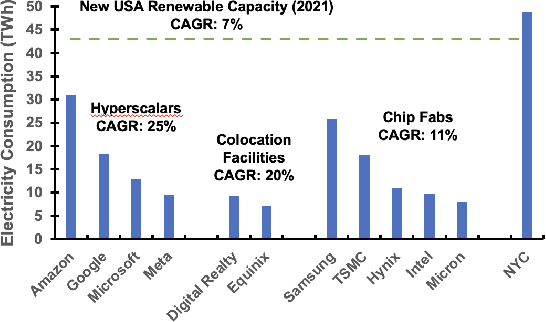
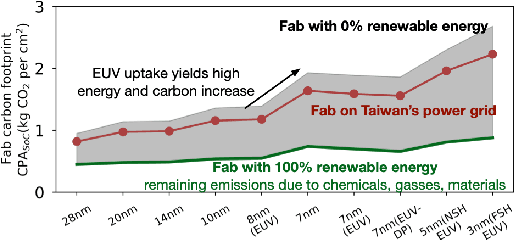
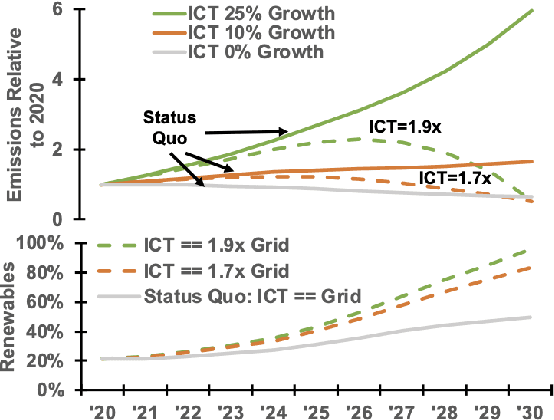
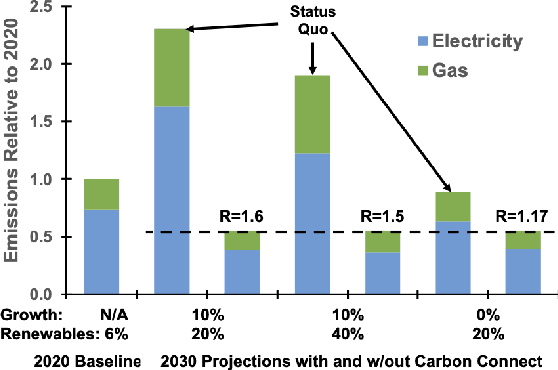
Abstract:Computing is at a moment of profound opportunity. Emerging applications -- such as capable artificial intelligence, immersive virtual realities, and pervasive sensor systems -- drive unprecedented demand for computer. Despite recent advances toward net zero carbon emissions, the computing industry's gross energy usage continues to rise at an alarming rate, outpacing the growth of new energy installations and renewable energy deployments. A shift towards sustainability is needed to spark a transformation in how computer systems are manufactured, allocated, and consumed. Carbon Connect envisions coordinated research thrusts that produce design and management strategies for sustainable, next-generation computer systems. These strategies must flatten and then reverse growth trajectories for computing power and carbon for society's most rapidly growing applications such as artificial intelligence and virtual spaces. We will require accurate models for carbon accounting in computing technology. For embodied carbon, we must re-think conventional design strategies -- over-provisioned monolithic servers, frequent hardware refresh cycles, custom silicon -- and adopt life-cycle design strategies that more effectively reduce, reuse and recycle hardware at scale. For operational carbon, we must not only embrace renewable energy but also design systems to use that energy more efficiently. Finally, new hardware design and management strategies must be cognizant of economic policy and regulatory landscape, aligning private initiatives with societal goals. Many of these broader goals will require computer scientists to develop deep, enduring collaborations with researchers in economics, law, and industrial ecology to spark change in broader practice.
 Add to Chrome
Add to Chrome Add to Firefox
Add to Firefox Add to Edge
Add to Edge